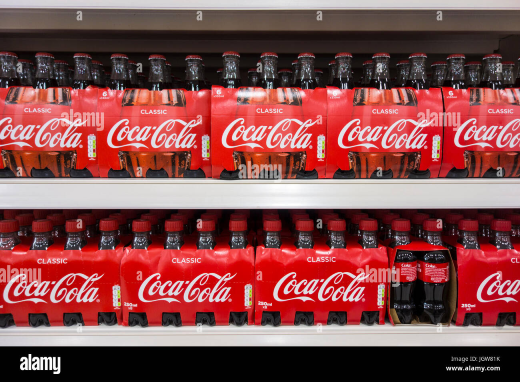Key Takeaways
- Coca-Cola bottlers shares drop 10% after 2025 outlooks disappoint.
- CCH and CCEP cite geopolitical risks and soft global demand.
- Tariff threats and consumer boycotts squeeze revenue forecasts.
- Coca-Cola Co. eyes shift to plastic to reduce aluminum costs.
Coca-Cola bottlers shares drop sharply after both Coca-Cola HBC and Coca-Cola Europacific Partners revised their 2025 revenue forecasts downward. Shares of both bottlers fell by about 10% in London trading on Wednesday, as investors reacted to weaker guidance, geopolitical tensions, and mounting consumer backlash in key markets. The decline outpaced the broader FTSE 100 index, which gained 0.2%.
Revenue Misses Trigger Investor Flight
Coca-Cola HBC, which bottles across 29 countries including Nigeria, Russia, and Italy, projected 2025 organic revenue growth at the top end of its 6% to 8% guidance. That fell short of market expectations for 8.8%. Meanwhile, Coca-Cola Europacific Partners cut its forecast to 3%–4%, down from a previous 4% baseline.
The earnings disappointment sparked immediate selling, wiping out billions in market value and raising questions over pricing strategy sustainability.
Revenue Forecast vs. Market Estimates
| Company | Forecast Range | Market Expectation | Deviation |
|---|---|---|---|
| CCH | 6%–8% | 8.8% | -0.8% |
| CCEP | 3%–4% | 4.0% | -0.5% |
Consumer Pushback Spreads Beyond Economics
The outlook downgrades came amid intensifying boycotts of U.S.-linked consumer brands in Muslim-majority markets. Coca-Cola HBC has seen sales pressure in Egypt, while CCEP reported similar sentiment in Indonesia — both tied to backlash over the Israel-Gaza war.
“Localized disruption is something we’re monitoring closely,” said Zoran Bogdanovic, CEO of Coca-Cola HBC. “While our production and sourcing models are resilient, we’re not immune to consumer sentiment shifts.”
Aluminum Tariffs Feed Margin Uncertainty
The geopolitical drag extends to material inputs. Coca-Cola Co., which holds stakes in both bottlers, warned last month that it may shift to cheaper packaging — including plastic — after the Trump administration imposed a 25% tariff on aluminum. The move threatens to inflate bottling costs globally.
For now, the company described cost pressures as “manageable,” though analysts remain wary.
Squeezed From All Sides: Analysts Raise Red Flags
Price increases have kept top-line revenue afloat, but analysts question how long that strategy can hold. “Price elasticity is starting to show,” said Ayisha Karim, consumer sector analyst at Ingalls & Snyder. “There’s a clear ceiling — particularly in lower-income markets.”
Volume resilience in some regions masked growing headwinds in others, with Asia-Pacific and EMEA flagged as soft spots.
Global Model Under Stress
Coca-Cola’s once-heralded decentralized bottling structure — long credited with insulating it from regional volatility — now faces growing pressure. Trade tensions, politicized consumption, and protectionist policies are converging to test its limits.
“These are not isolated pressures,” said Thomas Chiu, global strategist at HSBC. “They’re structural shifts.”



